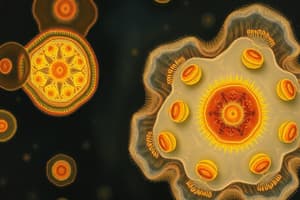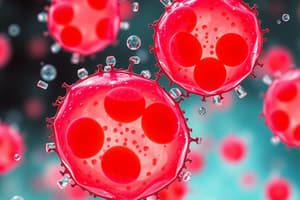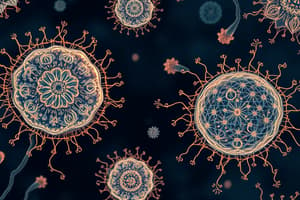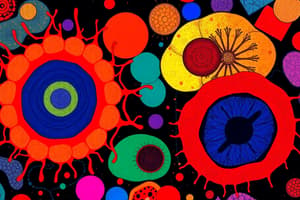Podcast
Questions and Answers
Which of the following is NOT a tenet of the cell theory?
Which of the following is NOT a tenet of the cell theory?
- Cells are the basic structural and functional unit of life.
- New cells arise from pre-existing cells.
- All living things are composed of cells.
- All cells have a membrane-bound nucleus. (correct)
Prokaryotic cells contain membrane-bound organelles.
Prokaryotic cells contain membrane-bound organelles.
False (B)
What is the region in prokaryotic cells where the single loop molecule of DNA is located?
What is the region in prokaryotic cells where the single loop molecule of DNA is located?
nucleoid region
The smooth endoplasmic reticulum (SER) is primarily involved in the synthesis of ______, phospholipids, and steroids.
The smooth endoplasmic reticulum (SER) is primarily involved in the synthesis of ______, phospholipids, and steroids.
Match the following organelles with their primary functions:
Match the following organelles with their primary functions:
Which of the following best describes the endomembrane system?
Which of the following best describes the endomembrane system?
The outer membrane of the nucleus is continuous with the smooth endoplasmic reticulum.
The outer membrane of the nucleus is continuous with the smooth endoplasmic reticulum.
What is the name given to the stacks of flattened saccules that compose the Golgi Apparatus?
What is the name given to the stacks of flattened saccules that compose the Golgi Apparatus?
The reactions that convert the energy in glucose to energy in ATP are collectively called ______.
The reactions that convert the energy in glucose to energy in ATP are collectively called ______.
Which of the following is a key difference between plant and animal cells?
Which of the following is a key difference between plant and animal cells?
Flashcards
Cell Theory
Cell Theory
All living things are made of cells; cells are the basic unit of life; new cells arise from pre-existing cells.
Prokaryotic Cell
Prokaryotic Cell
A cell that lacks a true membrane-bound nucleus or membrane-bound organelles. Characterized by having a single loop molecule of DNA in a nucleoid region.
Eukaryotic Cell
Eukaryotic Cell
A cell that contains a true nucleus and membrane-bound organelles.
Cytoplasm
Cytoplasm
Signup and view all the flashcards
Nuclear Envelope
Nuclear Envelope
Signup and view all the flashcards
Ribosomes
Ribosomes
Signup and view all the flashcards
Endoplasmic Reticulum (ER)
Endoplasmic Reticulum (ER)
Signup and view all the flashcards
Golgi Apparatus
Golgi Apparatus
Signup and view all the flashcards
Vesicles
Vesicles
Signup and view all the flashcards
Chloroplasts
Chloroplasts
Signup and view all the flashcards
Study Notes
- Living things are made of cells, the basic unit of life
- New cells come from pre-existing ones
- Biological levels of organization range from atoms to organisms, in this order: atoms, molecules, cells, tissues, organs, and organisms
Types of Cells
- Prokaryotes possess the prefix 'pro', which means "before"
- The term 'karyon' refers to nut, kernel, or nucleus
- Prokaryotes were the first successful organisms, existing 4 billion years ago, and were the only life form before eukaryotes
- Prokaryotes lack a true membrane-bound nucleus and membrane-bound organelles
- Prokaryotes contain a single loop of DNA located in the 'nucleoid' region
- Prokaryotes divide via binary fission
- Prokaryotes are present in all habitat types
- Prokaryotes are small, 1-2 um in diameter and 10 um long
- Bacteria, such as E. coli, are examples of prokaryotes
- Eukaryotes possess 'eu', which means "true"
- Eukaryotic DNA resides within a nuclear membrane
- Eukaryotes contain complex, membrane-bound organelles
- Eukaryotes include single-celled and all multicellular organisms, like plants and animals
- Eukaryotes first appeared 1.5 billion years ago
- Eukaryotes are about 10x larger than prokaryotes
- Eukaryotes divide through meiosis and mitosis
- All eukaryotic cells feature a cell/plasma membrane, nucleus, cytoplasm, and organelles
- Plant cells have a cell wall in addition to the cell/plasma membrane
- Cytoplasm comprises the contents between the nucleus and cell membrane
- Organelles are specialized structures that execute specific functions, enclosed by membranes
Nucleus
- A nuclear envelope, consisting of a double membrane, surrounds the nucleus, featuring pores for communication between the nucleus and cytoplasm
- The nuclear envelope consists of two lipid bilayers, with the outer membrane connected to the rough endoplasmic reticulum (RER)
- The nucleus regulates metabolic functions by controlling protein production and gene expression
- The nucleus controls protein synthesis
- Hereditary and genetic information (DNA) is contained in the nucleus
- Chromatin threads (uncoiled chromosomes) within the nucleus condense into chromosomes during cell division, containing DNA and histone proteins
- The fluid within the nucleus is the nucleoplasm
- The nucleus houses the nucleolus, which participates in the formation of ribosomal RNA (rRNA) and ribosomes, and is not surrounded by a membrane
Ribosomes
- Proteins are assembled in ribosomes
- Ribosomes consist of large and small subunits produced by the nucleolus
- Each subunit is made of rRNA and protein
- Ribosomes are present either freely in the cytoplasm or bound to the endoplasmic reticulum
- Free ribosomes synthesize proteins used in the cell, while bound ribosomes synthesize proteins for secretion or use in the cell membrane
- A group of ribosomes is known as a polyribosome or polysome
Endoplasmic Reticulum
- A vast membranous network continuous with the nuclear envelope's outer membrane, extending into the cytoplasm as tubular canals and vesicles
- The rough ER (RER), closest to the nucleus, has ribosomes attached, while the smooth ER (SER), further from the nucleus, lacks ribosomes
- The SER is more tubular
- The ER synthesizes,modifies, and transports macromolecules
- Ribosomes on the RER synthesize proteins that enter the ER, get modified if needed, and are transported to the Golgi Apparatus with transport vesicles that pinch off from the RER ends
- Insulin is produced by the RER in pancreatic cells
- Lipids, phospholipids, and steroids are synthesized in the smooth ER
- High amounts of Smooth ER is present in gland cells that produce steroid hormones
- The SER in liver cells detoxifies drugs
- Proteins and lipids are transferred, via transport vesicles formed by pinching off ER membranes, from the ends of RER and SER tubules to the Golgi Apparatus
Golgi Apparatus
- The Golgi apparatus processes, modifies, and packages macromolecules from the ER, distributing them via secretory vesicles and creating lysosomes
- The Golgi apparatus consists of flattened saccules called cisternae, arranged in stacks
- Proteins and lipids are modified in the Golgi, e.g. by adding carbohydrate chains to create glycoproteins and glycolipids
- Golgi products go to other cell parts and the cell membrane
- The Golgi Apparatus helps with secretion: secretory vesicles move to the cell membrane to discharge their contents outside the cell through exocytosis
Vesicles
- Membrane-bound sacs, either to transport substances within a cell (transport vesicles) or for secretion at the cell membrane (secretory vesicles)
Vacuole
- A large, single membrane-bound sac in the cytoplasm, filled with water and solutes
- Vacuoles serve as storage for water and salts
- Plant cells feature larger vacuoles filled with water and ions. This maintains turgor against the cell wall to keep the plant rigid
- Tonoplast is the membrane surrounding plant cell vacuoles
- Vacuoles are bigger than 100 nm, while vesicles are smaller than 100 nm, however, they share the same general structure
Lysosome
- Lysosomes are vesicles originating from the Golgi Apparatus, filled with hydrolytic enzymes
- Lysosomes facilitate intracellular digestion (by capturing and dismantling bacteria or damaged tissue) and autodigestion (by destroying debris and worn-out organelles)
- Lysosomes that contain debris degrade them
- Lysosomes merge with vesicles formed by endocytosis, digesting macromolecules into monomers released into the cytoplasm
- White blood cells are abundant in lysosomes
Peroxisome
- Vesicles containing enzymes that detoxify drugs and break down fats, especially in the liver
- Catalase, present in peroxisomes, breaks down hydrogen peroxide (H2O2), a product of fat and organic molecule breakdown
- Peroxisomes originate at the RER
- Free ribosomes create enzymes contained in a peroxisome
Endomembrane System
- The Endoplasmic Reticulum, Golgi apparatus, vesicles/vacuoles, and lysosomes collaborate to produce, transport, store, and secrete cellular products
Mitochondria
- The cell's energy-producing organelle, the mitochondria
- Mitochondria are double-membraned organelles, about the size of prokaryotes, featuring a smooth outer membrane and a folded inner membrane called cristae, which increases surface area where cellular respiration happens
- The fluid enclosed by the inner membrane, called the matrix, is a mixture of enzymes (that form ATP from glucose), DNA, and ribosomes
- Mitochondria are maternal in origin
- Cellular respiration converts the energy in glucose to energy in ATP
- Glycolysis in the cytoplasm converts glucose to pyruvate (producing 2 ATP, no oxygen needed, producing lactate)
- The citric acid cycle in the mitochondria produces 2 ATP, which requires oxygen
- The electron transport chain in the mitochondria produces 32-34 ATP and requires oxygen
Chloroplasts
- Chloroplasts produce carbohydrates by photosynthesis
- Chloroplasts are present in plant cells, but not in animal or fungal cells
- Chlorophyll imparts a green color
- Chloroplasts are double-membraned organelles enclosing a fluid-filled space called the stroma, which contains flattened sacs called thylakoids, arranged in stacks called grana. Chlorophyll is in the thylakoid membranes. Chloroplasts use sunlight to produce carbohydrates
- The stroma contains enzymes, DNA, and ribosomes
Cell Wall
- Plant cells are the only cells that have a cell wall
- Plant cell walls are made of cellulose and are rigid
- The cell wall is located outside of the cell membrane
Cytoskeleton
- The cytoskeleton is composed of filamentous protein structures that fill the cytoplasm
- Microtubules are 20-25 nm in diameter
- Intermediate filaments are 10 nm in diameter
- Microfilaments are 3-6 nm in diameter
- The cytoskeleton is a complex network facilitating cell movement (cilia and flagella components), shape maintenance, organelle movement and anchoring, vesicle movement, cytokinesis (via contractile ring constriction), chromosome movement (during mitosis and meiosis), and cell-to-cell communication
- Cytoskeleton structures can assemble and disassemble quickly due to their protein subunits
Centrosome
- The centrosomes is the origin and organizing centre of the cytoskeleton
- Centrioles are part of the centrosome in animal cells, replicating and positioning at right angles during cell division, organizing the spindle
Differences between Animal and Plant Cells
- Plant cells have cell walls, large central vacuoles, and chloroplasts, and they do not have centrioles
Studying That Suits You
Use AI to generate personalized quizzes and flashcards to suit your learning preferences.




